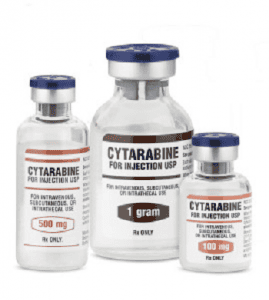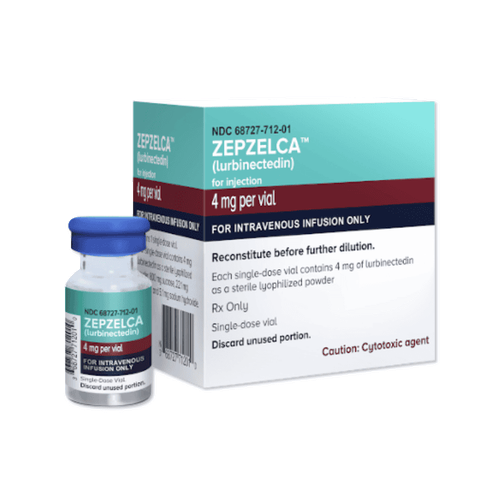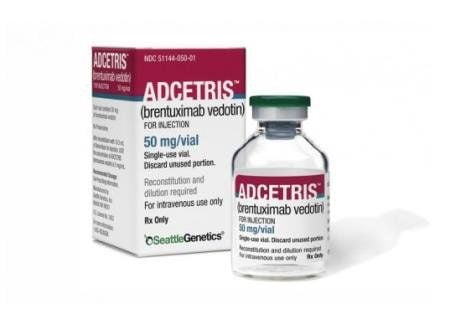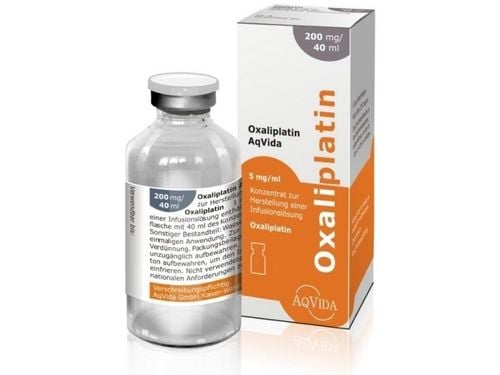This is an automatically translated article.
Liplatin 100 is the preferred drug class indicated for the treatment of cancer and acts on many types of tumors including colorectal tumors. So what is Liplatin 100 drug? What points to pay attention to and pay attention to when using? The following article will help you better understand the uses of Lipatin 100.
1. What are the uses of Lipatin 100?
1.1. What is Lipatin 100? Liplatin 100 is an anti-cancer drug that acts on the immune system. There is a drug Visa number-Registration number-SDK: VN-17875-14. Liplatin is a product manufactured by Laboratorios IMA S.A.I.C. - AG HEN TI NA and distributed by Viet Phap Pharmaceutical Co., Ltd.
Liplatin 100 contains the main ingredient, Oxaliplatin 100mg, which is prepared in the form of lyophilized powder for injection and packaged in a box with a vial.
1.2. What is Lipatin 100 used for? The drug Liplatin 100 affects the immune system as the main ingredient Oxaliplatin . Oxaliplatin has a broad spectrum of action in vitro, it induces cytotoxicity and in vivo has antitumor activity indicated for the treatment of gastrointestinal cancers such as colon cancer.
Adhere to using the drug according to the indications (uses, functions for which subjects) written on the instruction sheet for using Lipatin 100 or the doctor's prescription sheet.
2. Usage of Lipplatin 100
2.1. How to use Liplatin 100 Drugs Liplatin 100 is administered by infusion.
The use of Liplatin with Oxaliplatin does not require excessive rehydration. Liplatin is dissolved in 250 to 500 ml of 5% glucose (dextrose) solution to achieve concentrations above 0.2 mg per ml and administered as a peripheral or central intravenous infusion over 2 to 6 hours, and always should always be given prior to infusion of 5-fluorouracil.
In case of extravasation, the infusion should be stopped immediately.
Liplatin drugs containing Oxaliplatin must be diluted with solvents before use. Note that only the recommended solvents should be used to prepare and dilute this powder.
2.2. Dosage of Liplatin 100 The recommended dose for adjunctive therapy is 85 mg in m2 IV, repeated every 2 weeks, for 12 courses of treatment (6 months).
The recommended dose in the treatment of metastatic colorectal cancer is 85 mg per square meter, administered intravenously and repeated every 2 weeks.
In most cases, Liplatin containing the active ingredient oxaliplatin is used in combination with a continuous infusion of 5-fluorouracil according to the basic regimen.
Oxaliplatin loading dose and continuous intravenous infusion used in combination with 5-fluorouracil according to the treatment regimen and repeated every 2 weeks.
Renal impairment For patients with normal renal function, patients with moderate to mild renal impairment, the recommended dose is 85 mg per m2. For patients with severe renal impairment, the recommended starting dose is 65 mg per m2.
Patients with impaired liver function Liplatin has not been studied in patients with severe hepatic impairment. Observation of a group of patients with abnormal liver function tests from baseline showed no increase in acute toxicity of oxaliplatin. During clinical studies, no dose adjustment was necessary in patients with abnormal liver function tests.
Elderly Observations in a group of patients over 65 years of age found that the severe toxicity of Lipatin containing oxaliplatin was not increased when used as monotherapy, or when combined with 5-fluorouracil. Therefore, no dose adjustment is required in elderly patients.
Patients with stage III colon cancer For patients with persistent grade 2 sensory neuropathy that does not resolve, a reduction in the dose of Oxaliplatin to 75 mg per m2 should be considered. For patients with persistent Grade 3 sensory neuropathy, treatment discontinuation should be considered. There is no need to adjust the 5-fluorouracil/leucovorin infusion regimen.
Liplatin containing Oxaliplatin 75 mg per m2, 5-fluorouracil injection 300 mg per m2 and 5-fluorouracil 500 mg per m2 infusion over 32 hours are recommended for patients recovering from advanced gastrointestinal cancer 3/4 (despite prophylactic treatment) is either grade 4 neutropenia, or grade 3/4 thrombocytopenia. The next dose is used only when the neutrophil count is more than 1.5 x107 per L and the platelet count is more than 75 x109 per L.
Handling missed dose: Prescription drugs require a doctor's prescription. specialist or pharmacist. Over-the-counter medicines require a leaflet from the manufacturer. Carefully read and follow the exact dose indicated on the prescription or medication leaflet. If you miss a dose, you should contact your doctor for detailed instructions.
Treatment of overdose: There is no antidote for Lipatin 100 containing oxaliplatin. In the event of an overdose, side effects can be severe.
Blood parameters should be checked and symptoms should be treated.
3. Contraindications of Liplatin 100
Contraindicated to use Liplatin 100 for the following patients:
Patients with a history of allergy to Oxaliplatin drug ingredients. People who are breastfeeding. Patients with myelosuppression prior to the initiation of the first course of treatment, based on neutrophil counts below 2×109/L, or platelet counts below 100×109/L. Patients with peripheral sensory neuropathy, with a decline in neurological functions prior to the first course of treatment. Severely impaired renal function (creatinine clearance less than 30 ml/min). Do not share Liplatin 100 with drugs containing alkaline substances or solutions (especially 5-fluorouracil, alkaline solvents, tromectamol or folinic acid drugs containing trometamol as excipients). Do not mix medicine, dilute the drug in saline solution. Do not use Liplatin 100 drug mixed with other drugs to make solution for infusion or infusion with other drugs. Do not use aluminum injectors. Drug Interactions
In patients who received a single dose of 85 mg per m2 of oxaliplatin immediately prior to 5-fluorouracil administration, there was no change in 5-fluorouracil concentrations.
In vitro, there was no significant change in the binding of oxaliplatin to plasma proteins when administered with the following substances: erythromycin, salicylates, granisetron, paclitaxel and sodium valproate.
For pregnant and lactating women
Liplatin 100 contains Oxaliplatin which has the potential to cause death or teratogenicity to the fetus. And therefore not recommended during pregnancy, should only be considered after a risk assessment of the patient's fetus and with the patient's consent.
Liplatin 100 excreted in human milk has not been studied. Liplatin 100 is contraindicated during lactation.
4. Note when using Lipatin 100
Liplatin 100 contains the ingredient Oxaliplatin which is only used in specialized oncology and when used must be under the supervision of an experienced oncologist.
Because there is little information on safety when used in patients with moderate renal function impairment, the use of the drug should be considered after assessing the benefit and risk for the patient.
In this case, the patient's renal function should be closely monitored and the dose adjusted according to the toxicity of Liplatin 100.
Patients with a history of allergy to platinum active ingredients must be monitored. allergy symptoms.
If reactions resembling anaphylaxis to oxaliplatin occur, the infusion should be stopped immediately and symptomatic treatment instituted.
Subsequent re-administration of oxaliplatin is contraindicated.
In case of extravasation, stop the infusion immediately and initiate symptomatic treatment.
The neurotoxicity of oxaliplatin must be carefully monitored, especially when co-administered with drugs with specific neurotoxicity. A neurological examination should be performed before each infusion and periodically thereafter.
For patients with pharyngo-laryngeal dysesthesia, within or a few hours after a 2-hour infusion, the next infusion should last more than 6 hours.
5. Side effects of Liplatin 100
Very common: Injection site reactions (Extravasation can cause pain and inflammation at the injection site, which can be severe and uncomfortable, especially when oxaliplatin is given through a peripheral vein) Fever (Common allergic reactions such as skin rash, especially urticaria, conjunctivitis, rhinitis. Peripheral sensory nerve disturbances, headache, paresthesias. Diarrhea, nausea, vomiting, inflammation. mouth or mucositis, stomach pain, constipation, anorexia, back pain, nosebleeds, infections, shortness of breath, cough, skin disorders, hair loss, taste disorders Blood: Anemia , neutropenia, thrombocytopenia, leukopenia, lymphocytopenia Biochemistry: high alkaline phosphatase, high bilirubin, abnormal blood sugar, high LDH, hypokalemia, elevated liver enzymes (SGPT/ALAT) , SGOT/ASAT), abnormal serum sodium Common: Facial flushing Chest pain, weight loss (treatment of metastases) Dizziness, autonomic neuritis, meningeal irritation Dyspepsia, reflux Gastroesophageal reflux, hiccups, joint pain, bone pain. Hematuria, thrombophlebitis, pulmonary embolism, rectal bleeding. Depression, insomnia. Rhinitis, upper respiratory tract infection. Exfoliation of the skin (such as hand-foot syndrome), erythema, rash, excessive sweating, adnexal disorders. Urinary retention, abnormal and frequent urination. Conjunctivitis, astigmatism. Blood: Febrile neutropenia/infectious neutropenia (such as grade 3⁄4 neutropenia and true infection). Biochemistry: High serum creatinine. Uncommon: Intestinal obstruction, intestinal obstruction, metabolic acidosis. Excitement. Toxicity to the organ of hearing. Rare: Immune allergy, thrombocytopenia, anemia. Language disorder. Colitis, including diarrhea caused by Clostridium difficile. Interstitial lung disease, pulmonary fibrosis. Deaf.
Please dial HOTLINE for more information or register for an appointment HERE. Download MyVinmec app to make appointments faster and to manage your bookings easily.













